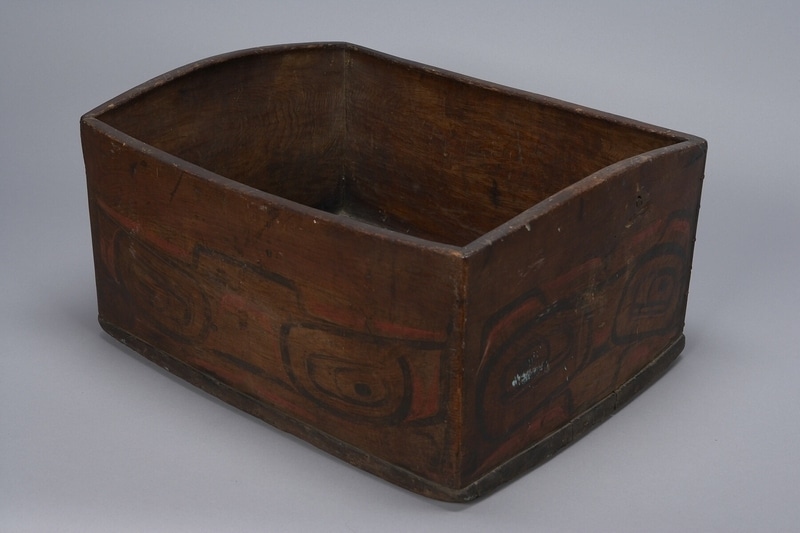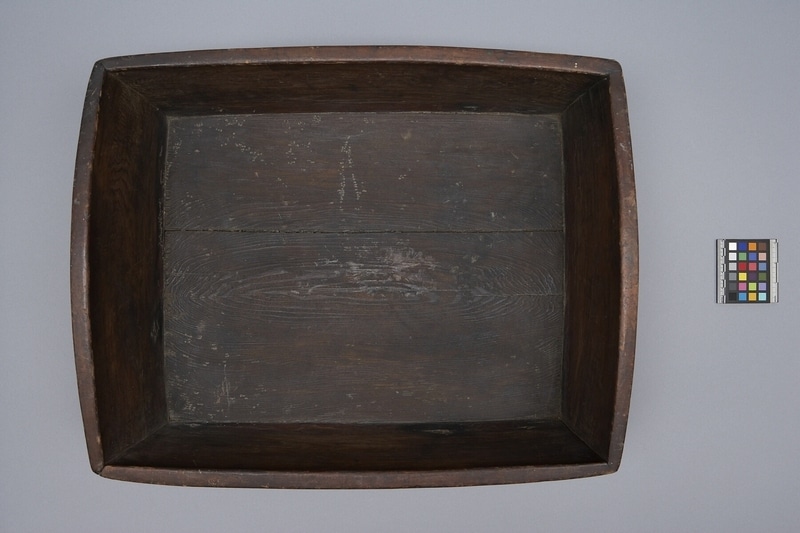Bentwood Bowl Item Number: Nb667 from the MOA: University of British Columbia



Description
Large rectangular bentwood dish with an undulating rim and painted designs in black and red, on sides and ends. Wide red band around rim is faded. The dish has three kerfed corners and is pegged together with 7 nails at the fourth corner. The base is pegged to the sides with nails.
History Of Use
Bentwood dishes were usually used for serving food, including fish oil, at feasts. They were also used as trade goods or gifts, and were symbols of wealth and prestige.
Cultural Context
serving; status; ceremonial
Iconographic Meaning
According to Wilson Duff, the imagery on bowls or boxes may be deliberately ambiguous to allow the owner to assign his own crest associations to the bowl and or box. The crest figures on the bowl protect the items stored within. These protectors are said to inhabit the boxes on which they are portrayed. It may also be that the imagery on boxes or bowls is more complex than simple crest representations.
Specific Techniques
Bentwood, or kerfed-corner, containers are constructed by a process unique to the Northwest Coast Aboriginal peoples. The carver begins with a single straight-grained plank of red cedar, or sometimes yellow cedar, spruce, or yew. The surface of the plank is finished with chisels, adzes, and knives; in earlier times, it was smoothed further with sandstone or dried sharkskin. Then three parallel kerfs, or grooves, are carved out at measured points across the width of the board, at right angles to the long edge. The kerfs, which will become three corners of the box, allow the board to be steamed until the wood fibres are softened, and then carefully bent to form a box with symmetrical sides. The final corner, as well as a fitted base, are joined and fastened with pegs (through drilled holes) or laced with spruce root or twisted cedar withes (branches). Storage boxes also have fitted lids of cedar, hollowed from the inside. Finally, painted compositions may be applied to the completed box and shallow carving added to bring the forms into relief. A well-made bentwood box is watertight. Historically, most boxes were used to store preserved foods and material goods; plain cooking boxes could be used to steam or boil food by adding water and heated stones.
Item History
- Made in British Columbia, Canada
- Collected between 1920 and 1950
- Owned by Florence E. Robins before October 11, 1988
- Received from Florence E. Robins (Donor) on October 11, 1988
What
Who
- Culture
- Northwest Coast
- Previous Owner
- Florence E. Robins
- Received from
- Florence E. Robins (Donor)
Where
- Holding Institution
- MOA: University of British Columbia
- Made in
- British Columbia, Canada
When
- Collection Date
- between 1920 and 1950
- Ownership Date
- before October 11, 1988
- Acquisition Date
- on October 11, 1988
Other
- Condition
- fair
- Accession Number
- 1298/0026